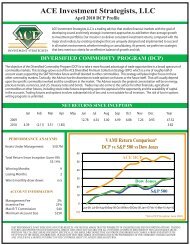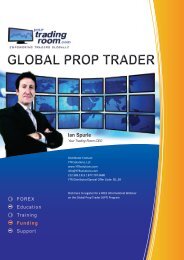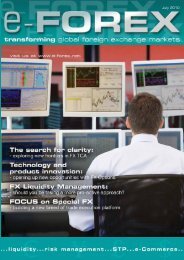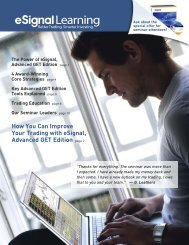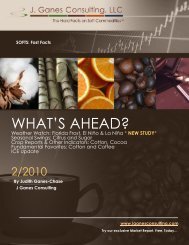You also want an ePaper? Increase the reach of your titles
YUMPU automatically turns print PDFs into web optimized ePapers that Google loves.
the average daily trade volume<br />
reached over US$60 billion,<br />
representing over 2% of the entire<br />
market and signaling plenty of<br />
room for future growth.<br />
At the end of 2009, the retail FX<br />
market is expected to reach<br />
US$125 billion in average daily<br />
trade volume, representing over<br />
3% of the global FX market. This<br />
is an impressive growth<br />
considering that the overall global<br />
FX market has declined in size<br />
from US$4.3 trillion in average<br />
daily trade volume in 2008 to<br />
US$3.7 trillion in average daily<br />
trade volume by Q3 2009.<br />
Conclusion<br />
The potential growth of the retail<br />
FX market appears limitless at this<br />
point, as potential key<br />
<strong>com</strong>petition is still missing from<br />
The Retail FX Market: Growth, Consolidation and Evolution<br />
Figure 3: Market Share of Retail FX<br />
Source: Bank for International Settlements, Bank of England Foreign Exchange Joint Standing Committee (JSC), New York Foreign Exchange Committee,<br />
Singapore Foreign Exchange Market Committee, Canadian Foreign Exchange Committee, Tokyo Foreign Exchange Joint Standing Committee, Aite Group estimates<br />
the <strong>com</strong>petitive landscape. One<br />
such group is the major dealing<br />
banks that have, to date,<br />
functioned simply as liquidity<br />
providers to the leading retail FX<br />
players. As evidenced by the direct<br />
entrance of Deutsche Bank and<br />
Citi into the retail market, Aite<br />
Group expects other dealing banks<br />
with significant retail businesses to<br />
seek new revenue sources from the<br />
retail FX market.<br />
One glaring absence from the<br />
retail FX market has been the<br />
traditional online brokers in the<br />
United States, such as Charles<br />
Schwab, E*Trade, and others. In<br />
the past, the lack of regulatory<br />
guidance and reputational risk<br />
may have played a role in<br />
dissuading these firms from<br />
providing FX trading as part of<br />
their active trading platform.<br />
However, as they continue to<br />
focus on enhancing functionality<br />
within their active trader<br />
platforms, most of the traditional<br />
online brokerage firms will have<br />
no choice but to seriously consider<br />
the addition of FX into their<br />
overall asset class coverage or risk<br />
losing out on capturing this most<br />
liquid market to specialized retail<br />
FX brokers and large global banks.<br />
Whether through the use of active<br />
trading firms profiled in this<br />
report or increasingly through<br />
other FX-related products, such as<br />
FX deposit products, FX funds, or<br />
FX ETFs, a growing number of<br />
retail clients are turning to FX as<br />
an asset class to diversify their<br />
portfolios and to achieve the<br />
higher returns that are unlikely to<br />
be gained from more traditional<br />
asset classes.<br />
january 2010 e-FOREX | 25




